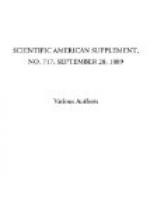forms an indent in what would otherwise be a straight
line on the paper. The distance pen, by a similar
arrangement, traces another line on the cylinder in
which are indents corresponding to fixed distances
of travel along the tank, the indents being caused
by small projections which strike a trigger at the
bottom of the carriage as it passes, and make electric
contact. From these time and distance diagrams
accurate account can be taken of the speed at which
the model and its supporting carriage have been driven.
Thus on the same cylinder is recorded graphically
the speed and resistance of the model. The carriage
may be driven at any assigned speed by adjusting the
governor of the driving engine already alluded to,
but the record of the speed by means of the time and
distance diagrams is more definite. When the
resistances of the model have been obtained at several
speeds, varying in some cases from 50 to 1,000 feet
per minute, the speeds are set off in suitable units
along a base line, and for every speed at which resistance
is measured, the resistance is set off to scale as
an ordinate value at those speeds. A line passing
through these spots forms the “curve of resistance,”
from which the resistance experienced by the model
at the given trial speeds or any intermediate speed
can be ascertained. The resistance being known,
the power required to overcome resistance and drive
the actual ship at any given speed is easily deduced
by applying the rule before described as the law of
comparison.—
The Steamship.
* * * *
*
THE SHIP IN THE NEW FRENCH BALLET OF THE “TEMPEST.”
A new ballet, entitled the “Tempest,”
by Messrs. Barbier and Thomas, has recently been put
upon the stage of the Opera at Paris with superb settings.
One of the most important of the several tableaux exhibited
is the last one of the third act, in which appears
a vessel of unusual dimensions for the stage, and
which leaves far behind it the celebrated ships of
the “Corsaire” and “L’Africaine.”
This vessel, starting from the back of the stage,
advances majestically, describes a wide circle, and
stops in front of the prompter’s box.
[Illustration: FIG. 1.—SHIP OF THE
“TEMPEST,” IN PROCESS OF CONSTRUCTION.]
[Illustration: FIG. 2.—SETTING OF
THE SCENERY BEFORE AND AFTER THE APPEARANCE OF THE
SHIP.]
As the structure of this vessel and the mechanism
by which it is moved are a little out of the ordinary,
we shall give some details in regard to them.
First, the sea is represented by four parallel strips
of water, each formed of a vertical wooden frame entirely
free in its movements (Fig. 2). The ship (Figs.
1, 2, 3, 4 and 5) is carried by wheels that roll over
the floor of the stage. It is guided in its motion
by two grooved bronze wheels and by a rail formed of
a simple reversed T-iron which is fixed to the floor
by bolts. In measure as it advances, the strips




